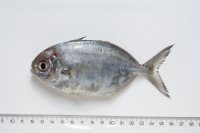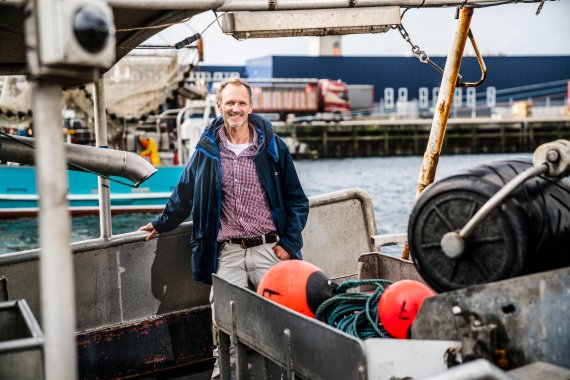text Tessa Louwerens photo Bram Belloni
Bram Couperus, a researcher at Wageningen Marine Research in Ijmuiden, has had a fascination for plants and animals since childhood. He feels a strong need to name everything. ‘If I am walking through the forests and I hear birds sing, I want to be able to name them. It gives me something to hold onto: each habitat has its own species that belong there. For me, this diversity of species is the basis of ecology.’
Couperus regularly goes out to sea for his work, to study fish stocks of species such as herring and blue whiting. ‘The sea is a black box; to me that is what is so exciting about it. On the echo scans you see a patch and that is a school of fish. But you never know beforehand exactly what you will catch. One time the school is full of blue whiting, and the next time there are 50 different species in it.’ Such cases bring out Couperus’s need for order: ‘I can’t stand it if I come across something which I can’t identify.’
Nondescript fish
Last month, when Couperus had an unfamiliar and nameless fish in front of him, he was itching to identify it. ‘It doesn’t matter how busy I am, if people find something unusual, I am very happy to take the time to find out what it is.’ And this included Dutch Kotter fisher Hans Tap, who found a 15 centimetre-long fish in his shrimp net (see inset). ‘Hans comes by occasionally if he finds something unusual, because his Kotter is moored very near our office. For instance, he brought in an unusual shrimp, Palaemon serratus. It is in the aquarium here at the reception desk now.’
Couperus couldn’t place the fish at first. ‘I’ve been doing this work for 25 years and I usually think, oh, that is from that family. But this was such a nondescript little fish, with no particular characteristics. My first impression was that it looked like a cross between a horse mackerel and a sea bream, with a remarkably small mouth.’
Needle in a haystack
Couperus and a colleague of his delved into the field guides of the North Atlantic and the Mediterranean. In vain. ‘Then we thought: maybe it comes from the western Atlantic. So we sent photos to our sister institute NOAA in Woods Hole in the United States.’ Sadly, the pictures didn’t ring any bells for their American colleagues either. ‘Then we sent the photos to a colleague in Australia. But they weren’t taken very seriously there.’

On 8 August Dutch Kotter fisher Hans Tap caught a mystery fish just south of the Maasvlakte, part of the Europoort harbour. He brought it to Wageningen Marine Research in Ijmuiden, where, after some smart detective work, biologist Bram Couperus identified it as a specimen of Ariomma indicum, or the Indian driftfish. The fish has now been preserved and will be kept at Naturalis Biodiversity Centre in Leiden. Couperus was invited to come up with a Dutch name. ‘In Australia they call it the Eyebrow fish, and there is indeed a bit of a ridge above its eyes. But in the end it’s the British name that is most widely accepted so I went for a translation of that. And I call this specimen Drifty.’ Photo Oscar Bos, Wageningen Marine Research.
In his determination to find this fish’s name, Couperus systematically combed through Fishbase, a database with all the fish species in the world. ‘It really was like looking for a needle in a haystack, especially because that fish was not exactly eye-catching. But I was lucky because within half an hour I had found a picture of it.’ And then at last the fish had a name: the Indian driftfish, known to scientists as Ariomma indicum, a perch-like fish only found in the tropical or sub-tropical waters of the Indian Ocean.
Ballast water
How the fish ended up in the North Sea is a mystery. ‘If it had anything to do with climate change, you would expect there to be more sightings, along the west coast of Africa for instance. But this is the first time it has been spotted in the Atlantic region.’ In theory the fish could have been transported in the ballast water of a ship, as an egg or larva. ‘But the fish was already 15 centimetres long, which meant it would have to have survived a winter in the cold North Sea. On the other hand, I can hardly imagine that an adult fish could survive a voyage of several weeks in the ballast water tank of a ship.’
The find is very exceptional, says Couperus. ‘We quite often see exotic species turning up in the North Sea, but we usually have an explanation for it. Several species come here from eastern Europe, for instance, through the Main-Danube canal.’ So the biologist is eager to know whether there are any more fish of this species in the North Sea, and he has asked fishers to report them. ‘Fishers are the likeliest to discover something special: they go into the same zones year in year out. But I think they often don’t notice unusual catches, or they just think “funny fish” and throw it overboard.’
Commercial species
Identifying exotic species is not Couperus’s daily work. ‘The annual surveys by Wageningen Marine Research are for stock estimates for commercial fish species. Species for which there is no market do not get priority. I do my best to pay some attention to them in between all the other work. And with some success, because at present we are collaborating with the Pelagic Freezer-trawler Association (PFA) on a species identification guide.’ Perhaps Drifty, as Couperus calls his find, could be added to the guide.

